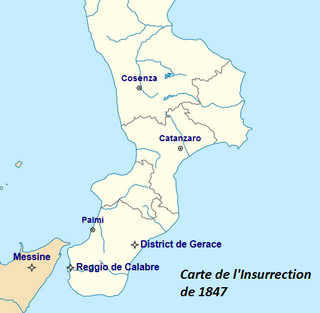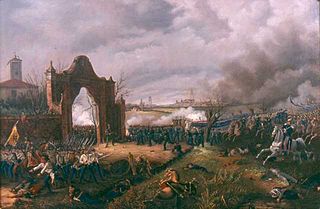 W
WThe 1848 Revolutions in the Italian states, part of the wider Revolutions of 1848 in Europe, were organized revolts in the states of the Italian peninsula and Sicily, led by intellectuals and agitators who desired a liberal government. As Italian nationalists they sought to eliminate reactionary Austrian control. During this time period of 1848, Italy was not a unified country, and was divided into many states, which, in Northern Italy, were ruled by the Austrian Empire. A desire to be independent from foreign rule, and the conservative leadership of the Austrians, led Italian revolutionaries to stage revolution in order to drive out the Austrians. The revolution was led by the state of the Kingdom of Sardinia. Also, the uprisings in the Kingdom of Lombardy–Venetia, particularly in Milan, forced the Austrian General Radetzky to retreat to the Quadrilatero (Quadrilateral) fortresses.
 W
WThe Five Days of Milan was an insurrection and a major event in the Revolutionary Year of 1848 that started the First Italian War of Independence. On 18 March, a rebellion arose in the city of Milan, and in five days of street fighting drove Marshal Radetzky and his Austrian soldiers from the city.
 W
WThe Insurrection of 1847 in the Two Sicilies is a series of three revolts that happened in September 1847 in the Kingdom of the Two Sicilies. Its aim was the unification of Italy and the establishment of either a constitutional monarchy or a republic. The insurrection is often considered as a continuation of the Neapolitan revolution of 1820 and at the same time as a foretaste of the Sicilian revolution of 1848 and of the spring of nations.
 W
WDaniele Manin was an Italian patriot, statesman and leader of the Risorgimento in Venice. He is considered by many Italian historians a hero of the Italian unification.
 W
WThe sortie on Mestre occurred during the revolutionary year of 1848 on October 27. Italian volunteers charged the Austrian fortification, took the town and withdrew, with the loot of three baggage-waggons, eight horses, large quantity of ammunition and the military chest, back to the fort at Marghera.
 W
WThaddeus Phelps Mott was a 19th-century American adventurer, sailor and soldier of fortune. A former Union Army officer during American Civil War, he also took part in wars in Mexico, Italy, and the Ottoman Empire. He was primarily responsible for recruiting former Union and Confederate soldiers for service in the Egyptian Army, in which he held the rank of major general, and was the first officer to take service with the Khedive Isma'il Pasha as his aide-de-camp in 1870. At the time of his death, he was also the last surviving son of the eminent surgeon Valentine Mott.
 W
WThe Republic of San Marco or the Venetian Republic was an Italian revolutionary state which existed for 17 months in 1848–1849. Based on the Venetian Lagoon, it extended into most of Venetia, or the Terraferma territory of the Republic of Venice, suppressed 51 years earlier in the French Revolutionary Wars. After declaring independence from the Habsburg Austrian Empire, the republic later joined the Kingdom of Sardinia in an attempt, led by the latter, to unite northern Italy against foreign domination. But the First Italian War of Independence ended in the defeat of Sardinia, and Austrian forces reconquered the Republic of San Marco on 28 August 1849 following a long siege.
 W
WThe Roman Republic was a short-lived state declared on 9 February 1849, when the government of the Papal States was temporarily replaced by a republican government due to Pope Pius IX's flight to Gaeta. The republic was led by Carlo Armellini, Giuseppe Mazzini, and Aurelio Saffi. Together they formed a triumvirate, a reflection of a form of government in the ancient Roman Republic.
 W
WThe Sicilian revolution of independence of 1848 occurred in a year replete with revolutions and popular revolts. It commenced on 12 January 1848, and therefore was the first of the numerous revolutions to occur that year. Three revolutions against Bourbon rule had previously occurred on the island of Sicily starting from 1800: this final one resulted in an independent state surviving for 16 months. The constitution that survived the 16 months was quite advanced for its time in liberal democratic terms, as was the proposal of an Italian confederation of states. It was in effect a curtain raiser to the end of the Bourbon kingdom of the Two Sicilies which was started by Giuseppe Garibaldi's Expedition of the Thousand in 1860 and culminated with the siege of Gaeta of 1860–1861.
 W
WThe Straw Man is a 1957 novel by the French writer Jean Giono. Its French title is Le Bonheur fou, which means "the mad happiness". The story is set in the 1840s and follows Angelo Pardi as he is caught up in plots leading up to the Italian revolution of 1848. The novel is a standalone sequel to The Horseman on the Roof, which is set earlier and also features Pardi as the main character. Several standalone sequels followed in what is known as the Hussar Cycle. The Straw Man was published in English in 1959, translated by Phyllis Johnson.
 W
WThe First Italian War of Independence, part of the Italian Unification (Risorgimento), was fought by the Kingdom of Sardinia (Piedmont) and Italian volunteers against the Austrian Empire and other conservative states from 23 March 1848 to 22 August 1849 in the Italian Peninsula.